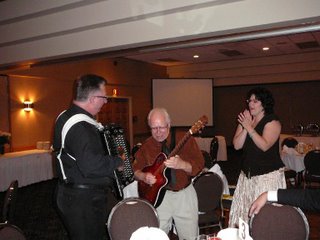Or that's what the commercials say. (PNE, by the way, is the Pacific National Exhibition - on at the fairgrounds in Vancouver until Monday, September 4th)
We went Monday afternoon. On our way from the parking lot, we caught a glimpse of these motocross magicians. So we found seats on the bleachers overlooking the track and were properly wowed for about 45 minutes. (And I thought watching my son skateboard was bad for the heart!)
Wednesday, August 30, 2006
PNE - the best part of summer
Posted by
Violet N.
at
7:41 PM
0
comments
![]()
![]()
Motocross - everyone on the course.
We met friends at one of the gates after that, then wandered over to the Superdogs show. If you’re a dog lover and you get the chance, take in the Superdogs! (video)
Posted by
Violet N.
at
7:36 PM
0
comments
![]()
![]()
Our trip to the fair also included a walk through the barns to ooh and aah over these animal babies.
Donkey and colt
Posted by
Violet N.
at
7:35 PM
0
comments
![]()
![]()
Labels: critters, PNE events
We ended the night with thousands of others clapping, toe-tapping and singing along with Glen Campbell (Wichita Lineman, Rhinestone Cowboy, You've Lost that Lovin' Feeling, That's What You Get for Loving Me etc. etc.)
A good time was had by all!
Posted by
Violet N.
at
7:30 PM
0
comments
![]()
![]()
Labels: celebrities, events, PNE
Tuesday, August 29, 2006
critical book reviews
Yesterday I posted a critical book review. After posting it, I considered diluting the criticism, looking for more nice things to say and rewriting, perhaps even deleting the post altogether. I decided against all these. Instead, I’m going to give some of my history as a reviewer and thoughts about book reviews – and criticism in general.
1. I love good writing and am always on the lookout for new authors to follow.
2. I have never written a novel (though I have read a lot of fiction, along with taking courses and reading many books on how to write it). I have written and published a few short stories, though, and my little experience with writing fiction has proved it’s one of the hardest types of writing to get good at. As a reviewer of fiction, I often feel that I am really an armchair quarterback and though I have lots of opinions on what is wrong, I’m not sure I could do it better. I have great respect for fiction writers.
3. For years I avoided reading so-called Christian fiction. I found it was often poorly written and preachy.
4. Then I was introduced to several Christian novels (and novelists) that excited me.
- Francine Rivers’ Mark of the Lion series.
- The Mitford books by Jan Karon.
- Books by Dale Cramer
- Lately I’ve enjoyed Patty Hill, Sharon Hinck and Gilead by Marilynne Robinson.
These books encouraged me not to give up on Christian fiction but instead help publicize the books that are well done.
5. Though I’d reviewed a few books in past years, it wasn’t until I opened this blog that I began writing reviews of pretty much everything I read. It made the reading experience more meaningful as it forced me to analyze and process what I was reading.
6. After reviewing books for Stacey Harp’s Mind and Media (since changed to Active Christian Media) I was contacted by Bethany House to review fiction for them.
7. Thus I’ve been getting many hot-off-the-press books to read and have been exposing myself to genres (like Romance, Mom-Lit and Suspense) I would not likely choose to read. This has had its pluses. In the process I’ve been introduced to some very talented new writers. It also means that now I’m reading some books that don't appeal to me,
8. When I read books I don’t care for, I am in a dilemma. Should I consider the feelings of the publishing house and the author, or be honest? The personal, writer-vulnerable part of me wants to say nice things, being careful not to give offense or set myself up in a way which would invite attacks back at me. I know how much criticism can hurt. However, the consumer/reader part wants to tell it straight.
9. In the review below, I’ve obviously opted for telling it straight. However, I’ve discovered that it’s harder to write a critical review than a positive one, because it’s harder to figure out why I feel a book doesn’t work than why it does.
I’ve wondered, sometimes, if it’s simply a matter of genre. The romance genre, for example, typically focuses on inner feelings and tracks the moment-by-moment development of romantic love – something about which I simply don’t enjoy reading. So maybe I’m being overly critical because I don’t understand or appreciate the genre?
That may be part of it. However, I have read romance that I enjoy – and suspense, and all kinds of genres. So I hold to the belief that if something is well written, it will be enjoyable to read, no matter what the genre.
Also, I try to be specific in my criticism - not just say I don’t like a book but explain why and give examples.
10. I am hoping that criticism (coming from many more voices than just mine) will eventually improve the state of Christian fiction to the point where many more of these books will become must-reads for the fiction-reading public, Christian and non-Christian alike.
11. I also post some book reviews found here on Amazon.com and most on blogcritics.org Some of those have been chosen by blogcritic editors to be syndicated by Advance.net and appear in .com papers like cleveland.com. This increased exposure makes me even more aware of the potential my words have to damage a book or a writer. I agonize over whether to post negative reviews of Christian fiction more widely. Mostly I haven’t.
All the above to say that when you read my reviews, keep in mind that I am only one person who has definite tastes and will speak her mind. If you’re thinking of buying a book and you read a critical review here, look at other reviews before making your decision. (For A Hearth In Candlewood, for example, Harriet Klausner has rated this book 4/5 stars and written a mostly positive review here).
And to the authors about whose books I’ve been critical, please remember this Trumpism: It’s not personal, it’s business.
Filed in Book Reviews
Posted by
Violet N.
at
10:52 AM
0
comments
![]()
![]()
Labels: book reviews, writing
Monday, August 28, 2006
book review A Hearth in Candlewood
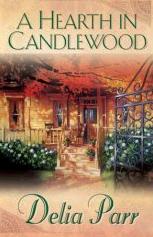 Title: A Hearth in Candlewood
Title: A Hearth in Candlewood
Author: Delia Parr
Publisher: Bethany House, August 2006, Paperback, 317 pages
Type: Historical Fiction
ISBN: 0764200860
A Hearth in Candlewood opens with Emma welcoming an unexpected and elderly guest to her boarding house in the dead of night. In this way author Delia Parr introduces us to the book’s main character, the 51-year-old widowed landlady Emma Garrett and her home, Hill House.
Hill House is located in the fictitious town of Candlewood, a canal settlement near the Erie Canal in the state of New York. The story begins in September of 1841 and encompasses just a bit more than a year. It details Emma’s struggles and triumphs as guests come and go from her boarding house, a developer hounds her to sell the property, she becomes embroiled in a family feud, her own enterprise comes into jeopardy and through it all she invokes God’s presence, help and approval.
The setting seemed authentic. The book did a good job of portraying American small-town life and especially what it was like to run a boarding house in the mid 19th century. The historical events in which the story was set were interesting with the flux and change brought about by improved transportation via canals, the anticipation of the railroad, and the arrival of unscrupulous developers providing a potential for tension. It was also refreshing to have a middle-aged heroine for a change. However, despite all the above, I found this book a hard slog.
One problem I had with it was the main character, Emma. Though she was generous, helpful, hospitable and caring, her inordinate concern about appearances, impetuousness, stubborness and often outright bossiness kept me yo-yoing between like and dislike. In fact, I was more than a little pleased when, from time to time, she got the treatment she regularly dished out.
The plot too left me unsatisfied. It was slow-moving and tangential with detail that often cluttered rather than focused the story. Emma’s concerns were wide-ranging and busy-bodyish, and her actions in relation to other characters didn’t do much to dispel the stereotype of the meddling widow. There were build-ups that led to nothing (e.g. a horse riding episode where a big deal was made of Emma’s need to wear trousers – oh horrors, what would people think?! – and then the actual ride wasn’t described at all). A chicken incident near the end was belabored to unbelievable and ridiculous lengths. Even attempts at humor fell flat, with the characters doing all the laughing.
Themes addressed were family relationships, the role of women, especially as they relate to women being capable of managing their own business affairs (I fear Candlewood didn’t do much to further the cause), and the role that faith in God plays in daily life.
In this latter I was also disappointed. Though the author depicted Emma as breathing prayers and rehearsing comforting sayings in the middle of stressful times, her spirituality seemed superficial and used more like an amulet than entered into as a living relationship. There was little evidence of her gaining insight into her habitual and self-defeating behavior patterns or changing from her headstrong ways. Maybe this happens in the next books.
All that to say, I really can’t recommend this book, though it has been likened to the Mitford Series by Jan Karon – which I enjoyed. For those who do choose to give it a try, keep in mind that this book doesn’t tell the whole story. Books 2 and 3 of the Candlewood Trilogy are still to be released.
Thank you to Bethany House who provided a copy of the book for review.
Filed in Book Reviews
Posted by
Violet N.
at
11:43 AM
0
comments
![]()
![]()
Labels: book reviews, Christian fiction, historical fiction
Sunday, August 27, 2006
Saturday, August 26, 2006
it's all in the perspective

There was a stand of pine outside the window where we stayed last week. The way the window framed it, one could only see the bottom part -- a forest of legs below jagged-hemmed skirts. These woods reminded me of paintings of the Group of Seven – an Arthur Lismer perhaps.
They also reminded me of my everyday life. So often I feel somewhat bewildered and not sure of my way as I wander through the seemingly sunless and pathless forest of circumstances.
During this last week away, in the spirit of vacations, I avoided everything that would connect me to my suburban existence. I didn’t have to contend with the telephone, check my email or update my blog. It turned out to be a time of gaining perspective on life. Distanced from the clamor and the urgent, it was easy to rise from that forest floor and look at my life more objectively. I mulled over what has happened in the past months and pondered the direction and trends of past circumstances. And I began to pray and dream and make lists about the future
It’s like what I saw outside my window on the flight home. Of course at 30,000+ feet, one is above all that could surround of forest, city or mountain. The higher the plane climbs, the more insignificant seem all the efforts of people. How tiny the settlements appear, how skinny the roads, how insect-like the cars. Even the vast expanses of the natural world – the wildernesses, forests, prairies and mountains have their boundaries.
As we flew above all this, the light of the setting sun reflected on clouds below us. The sight of those glory clouds reminded me of God’s presence above the minutiae of the world below.
Even when the ground became visible again, now dark with the land features almost indistinguishable, the sun’s presence still stained the horizon. It was still there even though not visible to the people living in those mist- and dusk-shrouded valleys and hills.
I will try to remember this scene of largeness and God’s overarching presence as I re-enter the forest of my life.
Posted by
Violet N.
at
8:27 AM
0
comments
![]()
![]()
Labels: personal reflection
Friday, August 25, 2006
wasn't that a party!

and the beautiful bride
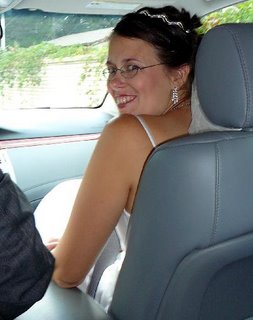
and her sweet little flower-girl sister.
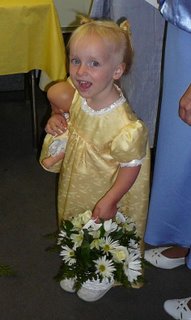
After the ceremony

there was singing
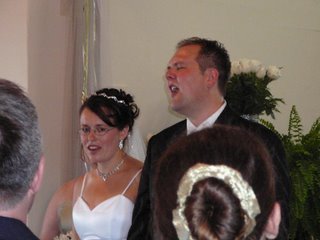
and more singing,
WASN'T THAT A PARTY!
Posted by
Violet N.
at
10:00 AM
0
comments
![]()
![]()
Wednesday, August 16, 2006
on waiting
Waiting is much more difficult than walking. Waiting requires patience, and patience is a rare virtue. It is fine to know that God builds hedges around His people -- when the hedge is looked at from the viewpoint of protection. But when the hedge is kept around one until it grows so high that he cannot see over the top and wonders whether he is ever to get out of the little sphere of influence and service in which he is pent up, it is hard for him sometimes to understand why he may not have a larger environment -- hard for him to "brighten the corner" where he is. But God has a purpose in all HIS holdups. "The steps of a good man are ordered of the Lord." reads Psalm 37:23.
On the margin of his Bible at this verse George Mueller had a notation, "And the stops also." It is a sad mistake for men to break through God's hedges. It is a vital principle of guidance for a Christian never to move out of the place in which he is sure God has placed him, until the Pillar of Cloud moves.
-- Sunday School Times, quoted in Streams in the Desert - Mrs. Charles E. Cowman
Posted by
Violet N.
at
9:44 AM
0
comments
![]()
![]()
Tuesday, August 15, 2006
Monday, August 14, 2006
make an exception
and watch The National on CBC television tonight. The buzz is that they will highlight Ratanak - a non-profit foundation, and Place of Rescue - an AIDS shelter and orphange near Phnom Penh run by Marie Ens (a Canadian and Christian and Missionary Alliance Missionary). She has been called, by some, Cambodia's Mother Theresa. It should be inspiring!
(The National airs 10:00 - 11:00 p.m. local time on CBC television. It can also be viewed on Real Player. Click on the "Watch the National Online" link this page (video updated 11:30 p.m. ET).
Posted by
Violet N.
at
4:30 PM
0
comments
![]()
![]()
Labels: people
wildflower journal - chicory

These sky-colored, daisy-like flowers (and they are part of the Compositae family) grow stemless on a rigid stalk. They were introduced from Europe but are now widely found on roadsides and in waste places throughout North America.
Chicory has a deep tap root which helps it grow in hard packed, rocky ground. The root of the chicory plant is sliced, kiln-dried, ground and roasted to a rich dark brown color, like coffee beans. When mixed with coffee, it adds body, aroma, color and mellowness. For many years chicory was used to stretch coffee supplies when pure coffee was a luxury. Chicory, by the way, has no caffeine. Apparently the specific taste of some famous New Orleans coffee brands is due to the blend of dark roasted coffee and chicory. Find some chicory FAQs and recipes for ground chicory beverages here.
Chicory’s first spring leaves are also edible as a green -- although I've never tried them. Find them low to the ground as they form a leaf-circle (basal rosette, resembling dandelion) early in the spring. Chicory is also related to endive - another common edible green.
Chicory flowers open and close every day. You’ll have to catch them in the morning, though, as most are closed by noon.
****************
For more wild flowers - check out this white collection from the Yukon (posted by Rebecca).
Posted by
Violet N.
at
3:48 PM
0
comments
![]()
![]()
Labels: nature, wildflowers
Saturday, August 12, 2006
kitsch - garden moments, 2nd week of August
My garden is humming along right now, though not doing anything exceptional. So this week instead of plants, I’m going to post a few pictures of garden kitsch - those folksy containers and bits of decoration which show another side of the gardener’s personality, or perhaps better said - in my case at least - the personality of the gardener’s friends and family. I don’t think I’ve ever bought this type of garden jewelry for myself - though I do enjoy it.
This sunflower stake from my sister lives between oregano and thyme, just behind an orange geranium.

The barn planter was a birthday gift from my neighbor. The chicken is actually something I bought, but for Mom. It came back here to roost after one of our several downsizings of her stuff.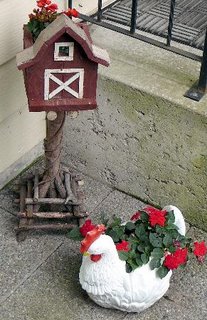
I got this little bug-flower bauble last year from a friend (pictured in last year’s garden). Sadly the gold ball shattered when I took it out and now the whole thing has mysteriously disappeared.
My favorite garden ornament seen lately, though, was in my sister-in-law’s garden in Saskatchewan – this fairy engrossed in a book.
(Previous 'garden moments' filed in Gardening)
*************
- Here's the latest from Rebecca's Yukon Garden. (She has links to previous postings - check the noticeable progress.)
- Islandsparrow's garden will make your mouth water.
- And I must show you this gorgeous farmer's garden - posted by Julana
Posted by
Violet N.
at
9:19 AM
0
comments
![]()
![]()
Labels: garden
Friday, August 11, 2006
poetry contest for the novice
Are you a Christian poet – as yet unpublished? Do I have a contest for you!
Utmostchristianwriters.com is running its first annual poetry contest for novice / unpublished poets. From Nathan Harms, Utmost’s webmaster in an email I got today:
We are in the final 2 weeks of our first annual Novice Christian Poetry Contest. We decided to sponsor this contest due to a great number of requests for a contest that would be more suited to unpublished Christian poets, but the number of entries is lower than expected to date.
If you qualify as an unpublished Christian poet, we encourage you to consider this contest. The total prizes that will be paid are US$1750 cash. There is no restriction on subject matter.
Poets, this is serious cash!
Utmost's home page has links to rules and entry form.
Deadline to mail entries is August 31st.
Posted by
Violet N.
at
10:23 AM
0
comments
![]()
![]()
Wednesday, August 09, 2006
book review: Relentless

Title: Relentless
Author: Robin Parrish
Publisher: Bethany House
Genre: Fiction / Suspense
ISBN: 9780764202216
With that intriguing first line, Robin Parrish launches us into Relentless, his debut novel that is combination science fiction, fantasy, suspense thriller and super hero comic book, though to my way of thinking is most like a video game – in book format.“Collin Boyd stepped off the Metro bus on his way to work, and across the street he saw himself strolling down the sidewalk.”
Collin, having morphed into the body of a stranger (Grant Borrows), with abilities and a reputation he didn’t know he had, is plunged into a lethal game of cat-and-mouse. The trouble is, he (and we) are never sure who the cat is or why he’s the mouse. As the story progresses, however, and we fit characters and incidents together, we begin to comprehend the extent of what’s going on here. For Grant’s shape-shift and whether or not he fulfills his prophesied destiny will impact not only him and the other changelings he meets, but the whole world.
As a plot-maker, Parrish does a masterful job of weaving his universe of characters (and there are many) into the non-stop action. Practically every chapter has its scene of high drama with car chases, sword fights, shadowy villains, and amazing escapes. His deftness in the story-telling department kept me reading just one more page, and one more, and one more...
The characters were another thing. Though realistic in a stock actor kind of way, I found it hard to empathize with them. The women were mostly beautiful and sexy, or gray and wise. The men were athletic, or brainy or both. All had the incredible ability to fight to the death, yet emerge alive and with the emotional and physical energy to keep running or pursuing. Perhaps I wasn’t taken with them too because I didn’t really like many of them – Grant included with his irritable, impatient, impulsive, petulant, self-pitying ways. As a whole, I’d say that character complexity, believability and likeability were sacrificed to plot.
The writing is strong, though, with vivid prose and a truly relentless pace maintained throughout. Parrish especially excels at the crisp description of fight and chase scenes, which abound. Gaffes, like Collin referred to as Grant before Grant is officially introduced (p.10), pus pouring out of an apparently uninfected wound only hours old (p. 32), and ‘retch’ spelled ‘wretch’ (p. 379) were rare exceptions.
The Christian aspect of this book is found in the existential questions it poses and its symbolism. Grant struggles the entire time with questions of purpose – why am I here and what am I meant to do. The plot plays games with another philosophical / theological dilemma as Grant and others grapple with issues of free well – do I do the things I do because I choose to do them, or am I playing a pre-determined role. And as the book progressed, I couldn’t help but also see how Grant’s portrayal as a potential savior, built on the fact he was the fulfillment of an ancient prophecy, paralleled another such one.
Though Relentless ends on a high note, many plot ends remain untied. We’ll have a bit of a wait to discover how they turn out. Book Two of Parrish’s Dominion Trilogy isn’t due for publication until the summer of 2007.
Thank you to Bethany House for providing a copy of Relentless for review.
Filed in Book Reviews (Fiction)
Posted by
Violet N.
at
8:29 PM
0
comments
![]()
![]()
Labels: book reviews, Christian fiction, fantasy, science fiction
Friday, August 04, 2006
garden moments - first week in August
The time of harvest has come. While I have no substantial heads of cabbage, great bunches of onions or blushing tomatoes to display, I harvest too. Cut flowers are pretty much a staple around the house these days. For how can one resist bringing some of that color inside?
For this arrangement of dahlia in sage leaves I got my inspiration from a slim book found among my mother’s things. Victorian Posies by Pamela Westland is a beautiful (and once scented) book. Opposite the drawing from it, below, are instructions on how to make "Aromatic Tussie Mussies."
Even before Victorian times, people used to make scented posies from herb leaves and flowers called tussie-mussies and carry them from room to room.
Gather a mixed bunch of herbs – there could be golden marjoram, pineapple mint, purple sage, silvery curry plant or lavender leaves, glossy bay leaves, and creamy-white feverfew flowers (also known as pyrethrum parthenium or bachelor’s buttons) – and tie them into small posies with a “ribbon” of long chives. You might like to place them in pretty wine glass on the dining table.
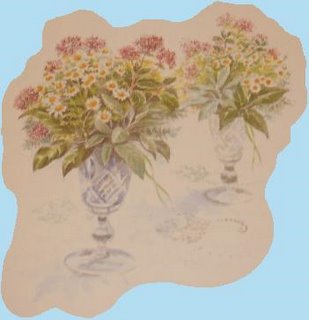
I had not thought of using aromatic herbs as greenery for cut flower bouquets. And though I don’t have nearly all the plants she mentions (and probably would always pass on the oniony-smelling chives even if I did have them) I do have sage. So I gave it a try. I find the bouquet is lasting nicely.

Prunings are also part of the harvest – as are these petunias, snipped from my hanging baskets, which were becoming altogether too leggy.

And of course even new hydrangeas last a little while in water. However, they don’t dry well at this stage – crinkling entirely in a few days. They have to be quite mature for the flowers to dry smooth and flat.
****************
Now this harvest make your mouth water.
(I'll post links to other gardens as I find them...)
Posted by
Violet N.
at
8:22 AM
0
comments
![]()
![]()
Labels: garden
Wednesday, August 02, 2006
wildflower journal - pearly everlasting

I first noticed Pearly Everlasting on the Mud Bay Park walk a couple of summers ago. I was surprised to find they were dry and brittle to the touch – a type of wild straw flower or ‘everlasting’ used in dried flower arrangements. They are in the same family (Compositae) as other straw flowers, daisies and tansy.
From this article I discover that they are perennials, last for months (as flowers), were used by Indians to stuff pillows, and are also known as Silverleaf, Moonshine, Cottonweed and None-So-Pretty.
Posted by
Violet N.
at
8:04 AM
0
comments
![]()
![]()
Labels: nature, wildflowers
Tuesday, August 01, 2006
new resolution
I'm going to try to impose some order and predictability and discipline on my blogging life. Thus I'll attempt to post here most Mondays, Wednesdays and Fridays. On Tuesdays and Thursdays I've promised my poetry blog to put up something there. We'll see how it goes...
Posted by
Violet N.
at
4:31 PM
0
comments
![]()
![]()
Labels: blogging








